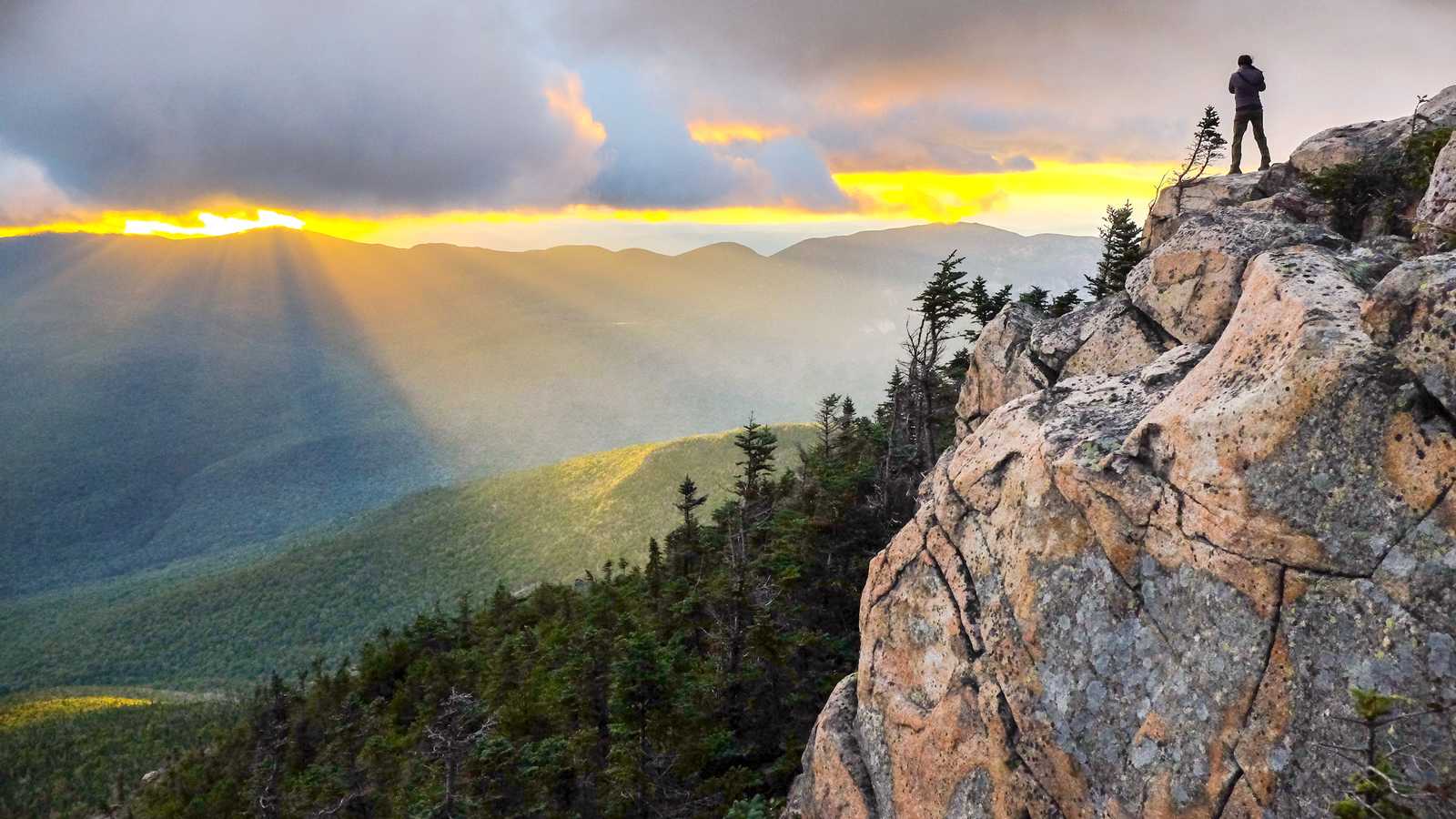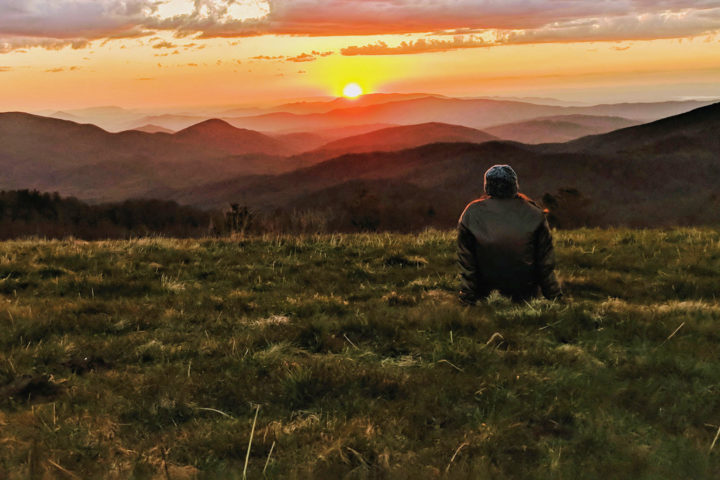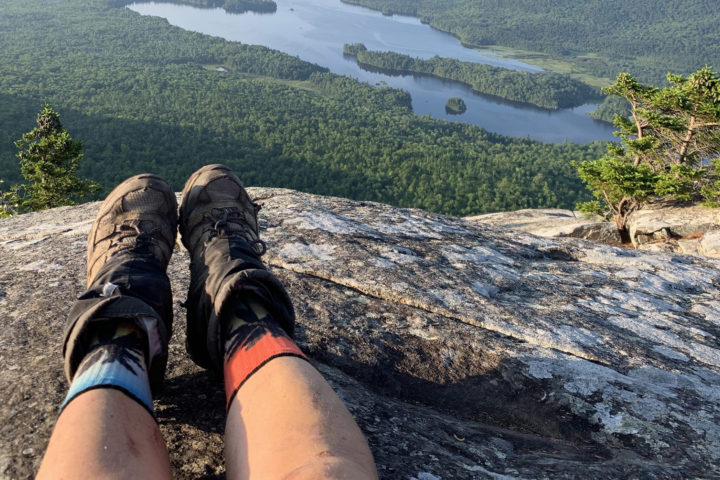By ATC Staff
Decoding the Appalachian Trail: Volume 2
October 31, 2024
As the only non-profit devoted exclusively to the entirety of the Appalachian National Scenic Trail and its landscape, the Appalachian Trail Conservancy (ATC) endeavors to keep its vast natural and scenic beauty healthy, resilient, and connected, so that everyone can experience the A.T.’s transformative power for generations to come.
To help provide a greater understanding of the A.T. and its thriving community of hikers, volunteers, doers, and dreamers, our “Decoding the Appalachian Trail” series defines the words, phrases, and symbols associated with the A.T. to help make the Trail more welcoming — in particular, a variety of the terms and definitions that are frequently used by A.T. visitors and supporters.

Photo courtesy of the Appalachian Trail Conservancy.
This volume focuses on some of the gear to bring with you, natural and man-made things you’ll see along the way, items to help you stay safe, hygienic, and going in the right direction, and other hiking terms you might not be familiar with.
Getting to the Trail and enjoying the awe-inspiring landscapes, thriving communities, and many recreation opportunities takes a little bit of knowhow, and the ATC is here to help!
See previous entries in the Decoding the A.T. series below:
Expand Each Category to Decode the A.T.
Things to Bring
Base layer
The items of clothing worn closest to the skin. It’s best if those items are designed to regulate body temperature, manage moisture, and provide comfort. Learn more about gear and layering clothing.
Bivy sack (AKA bivouac sac)
A lightweight, sometimes weatherproof bag that goes over a sleeping bag to provide extra protection from temperature and the elements.
Bladder
A sturdy bag that holds water, which can be dispensed through a lid, spout, or hose. It’s more malleable than a water bottle, so it can be packed in more creative ways, and is usually of a higher capacity, so it can carry more water. Since the material is often not as rigid or strong as water bottles, it must be handled with some level of care to prevent puncture.
Footprint
A large piece of fabric (usually made from ripstop nylon or tarp material) placed on the ground to act as a barrier between the ground and a tent. Footprints help to keep the tent clean, and protect the user from the elements (particularly water) potentially seeping into the tent floor.
GORP
Acronym that stands for “Good Ol’ Raisins and Peanuts”. A classic trail snack valued for its nutritional value, taste, and ease for packing and snacking on the trail.
Headlamp
A small device worn on the head that provides illumination. An essential for any hiking or camping that will occur after sundown. Headlamps are often more convenient than a flashlight, as they can be used hands-free. They are usually battery-powered, but some are rechargeable.
Puffy/Puffer
A type of jacket that is insulated (using either down feathers or a synthetic alternative). These jackets are often used because they are able to keep a person warm, but are very light-weight and easy to pack down, which makes them great for backpacking.
Things to See
Bald
A treeless, rocky summit, which may have other non-tree vegetation present. Not necessarily above the treeline, but nonetheless is treeless.
Berm
A rounded mound of soil constructed to visually improve a landscape’s layout, assist water run off to the correct drainage spots, or to create a privacy barrier.
Culvert
A structure that channels water past an obstacle or to a subterranean waterway.
Katahdin
The tallest mountain in Maine, with an elevation of 5,269 feet. It serves as the northern terminus of the Appalachian Trail and is located within Baxter State Park. Katahdin means “Great Mountain” by the Penobscot Native Americans. Learn more about finishing well at Katahdin.
Lean-to
A very basic freestanding structure that serves as shelter. Lean-tos consist of three sides with a pitched roof. There are many lean-tos on the A.T., which visitors are able to use for shelter and rest along their hike.
Privy
A backcountry toilet (similar to an outhouse or latrine). Usually located in highly trafficked areas, to divert the impact that would otherwise be caused by digging cat holes.
Scat
Animal poop. Keeping an eye out for scat is a great way to maintain awareness of animals that may be nearby.
Scramble/Scrambling
A section of trail that consists of steep, rocky terrain. It may not be steep enough to require use of external aids (such as ropes or rock climbing gear), but it is more involved than sections of a hike that are flat or only have a slight incline, and often requires hikers to utilize both hands and feet to go through.
Search & Rescue (SAR)
Coordinated program utilized to assist people in distress or imminent danger, such as when they are injured or lost. A.T. visitors should always plan ahead and prepare to lessen the chances of needing to call in SAR.
Switchbacks
A trail that ascends a path that increases in elevation (ex. A path that goes up a mountainside) by switching directions back and forth, so that the ascension is a more gradual zig-zag (as opposed to a fall line trail that goes straight up). Switchbacks make the distance longer but are generally easier on hikers’ bodies and are less subject to erosion than a straight-up path.
Things to Keep You Safe, Clean, and Going in the Right Direction
Cat hole
A small hole dug in the ground used to bury human waste in areas where there aren’t other restroom facilities. Holes should be 6-8 inches deep and dug in locations at least 200 feet away from trails, campsites, and water sources. Trowels are very handy for digging them. The only things that should go into them are human waste and toilet paper (and the dirt used to cover the hole back up)! No wipes, menstrual products, food scraps, or other trash should go in them (instead, those items should be carried out and disposed of elsewhere). In some locations, cat holes are prohibited because the environment is too delicate, in which cases waste should be carried out, such as in a WAG bag.
Compass
A piece of gear that is used (usually in conjunction with a map) to orient oneself to the surroundings, and to navigate one’s path. An essential in locations where GPS is unavailable.
Contour lines/contours
Lines on a topographic map that show elevation change. They curve based on the topography of the landscape depicted and are essential for determining locations where the trail is increasing or decreasing in elevation.
First-aid kit
Portable kit consisting of basic medical supplies. Hikers should always carry first-aid kits, as medical care can be challenging and time-consuming to reach in more remote area.
Hotspot
A red, tender area of skin that indicates a blister is about to form, which can result in pain when hiking. Hot spots are caused by pressure or friction, and often appear on the feet between the boot and the foot. It is best to take preventative measures to avoid them (and subsequent blisters) from forming.
Satellite messenger
An electronic safety device. Utilizes satellite signal to send out brief messages and/or location pings, even in the absence of regular cell phone service.
Soap
Oftentimes, people spending an extended period of time outdoors will bring a different type of soap than they use in their home. Usually, they’ll opt for an option that is biodegradable (better for the environment), multi-functional (can be used to wash hands and dishes, among other things), and concentrated (so that they don’t have to carry a large supply).
Surface poops
When people poop directly on the ground, rather than using a privy, digging a cat hole to burry it, or using a WAG bag. Surface poops should be avoided for a number of reasons: not only is it gross and unsightly, but they spread harmful bacteria and animals may eat them.
Ticks
Small parasitic insects, which may carry Lyme disease or other illnesses. Wearing long sleeves and pants and tucking in clothing helps to prevent them from getting on one’s body. Performing tick checks, particularly in areas that are harder to see (such as in the hair, groin, and under armpits) helps hikers to find and remove ticks before they are embedded, or to seek care as soon as possible, if any are embedded.
Toilet paper
If you’re reading this, you probably already know what toilet paper is. But in the outdoors, it is disposed of differently. If you’re using it at a privy, you can deposit it in there. But otherwise, you may need to either pack out your toilet paper or bury it in your cathole (depending on the location and situation).
Trowel
A small digging implement (akin to a hand-size shovel) usually made from metal or plastic. Most often used for digging holes in the ground to use as catholes. Very helpful in ensuring that the user is able to dig a cathole of sufficient depth.
WAG bag
Stands for Waste Alleviating Gel bag. A type of bag made of durable plastic designed specifically to store human waste (so that it may be carried out and later disposed of properly). Usage of a WAG bag may be necessary in areas where there are no toilets or privies, and in which digging cat holes is prohibited or impractical.
Things to Know
Backcountry
Primitive, remote, undeveloped areas of the environment.
Base weight
The weight of a fully loaded backpack at the start of a trip, excluding consumables such as food, water, and fuel. Your base weight will stay roughly the same, while the additional weight added by consumables will fluctuate over the course of a hike.
Cowboy camping
When you go camping and sleep out on the ground directly under the sky, without any built shelter, tent, or other sheltering apparatus overhead.
Cowboy coffee
When, instead of using any sort of filtration method for making coffee, a person instead puts the grounds directly in their cup, and just drinks around them.
False summit
A peak along a mountain which appears to be the summit, but is not the actual summit. When you’re standing on it, the area immediately surrounding it is lower in elevation, giving it the appearance of being the summit. Oftentimes disappointing for hikers, as it usually means they still have more uphill hiking to do before reaching the actual summit.
Ford
When you cross a body of water in a way that causes you to get your feet wet. Doing so can be dangerous, so it’s best to take precautions, such as wearing waterproof footwear with good traction, or going another way if the current is too strong. Learn more about river and stream crossing safety.
Hiker midnight
Around 9p.m. Oftentimes the time that a thru-hiker will head to bed. So named because it is usually earlier than they would go to sleep when not on trail, but because they are so tired from hiking all day, they end up going to sleep earlier.
Resupply/Resupply box
A package sent to top-off one’s supplies while on a longer hike. Since a backpacker can only carry so much weight, they will often plan ahead to have packages of supplies (for instance, batteries, food, and hygiene items) arrive at stops along their trail so that they can replenish the supplies they are carrying as they continue their hike.
Type 2 fun
Any sort of activity, experience, or event that is challenging or uncomfortable in the moment, but then is remembered fondly or viewed as fun after it is over. Whether due to feeling a sense of pride or satisfaction for having done it, or for it being a good story after-the-fact. For example, having a day in which you hiked the entire time in the rain, but later on, you are able to feel accomplished for having done so.
Zero day
A day (during the course of a multi-day hike) in which a hiker does not progress on their hike, but instead takes time to do any number of things, such as rest and recuperate, do laundry, or go into town.
Talking the talk is just the first step in getting more familiar with the A.T. Have more questions? Check out our FAQ page to learn more about the Trail.

Photo by Aaron Ibey.
Discover More

Plan and Prepare
Hiker Resource Library
A collection of resources for hikers to stay safe, healthy, and responsible on the Appalachian Trail.

BACK TO THE BASICS
Leave No Trace
Wondering how you can take care of outdoor places like the Appalachian Trail (A.T.)?

Plan and Prepare
Day Hiking
Ready to begin exploring the Appalachian Trail? Here’s everything you need to know to plan your next (or first) day hike.
